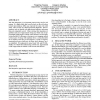77 search results - page 8 / 16 » Similarity Join Algorithms: An Introduction |
WWW
2004
ACM
14 years 10 months ago
2004
ACM
Web data integration is an important preprocessing step for web mining. It is highly likely that several records on the web whose textual representations differ may represent the ...
KDD
2005
ACM
14 years 10 months ago
2005
ACM
Online information services have grown too large for users to navigate without the help of automated tools such as collaborative filtering, which makes recommendations to users ba...
CLEF
2010
Springer
13 years 10 months ago
2010
Springer
This report explains our plagiarism detection method using fuzzy semantic-based string similarity approach. The algorithm was developed through four main stages. First is pre-proce...
ICFP
2000
ACM
14 years 2 months ago
2000
ACM
We show that standard formulations of intersection type systems are unsound in the presence of computational effects, and propose a solution similar to the value restriction for ...
KDD
2001
ACM
14 years 10 months ago
2001
ACM
The similarity join is an important operation for mining high-dimensional feature spaces. Given two data sets, the similarity join computes all tuples (x, y) that are within a dis...

